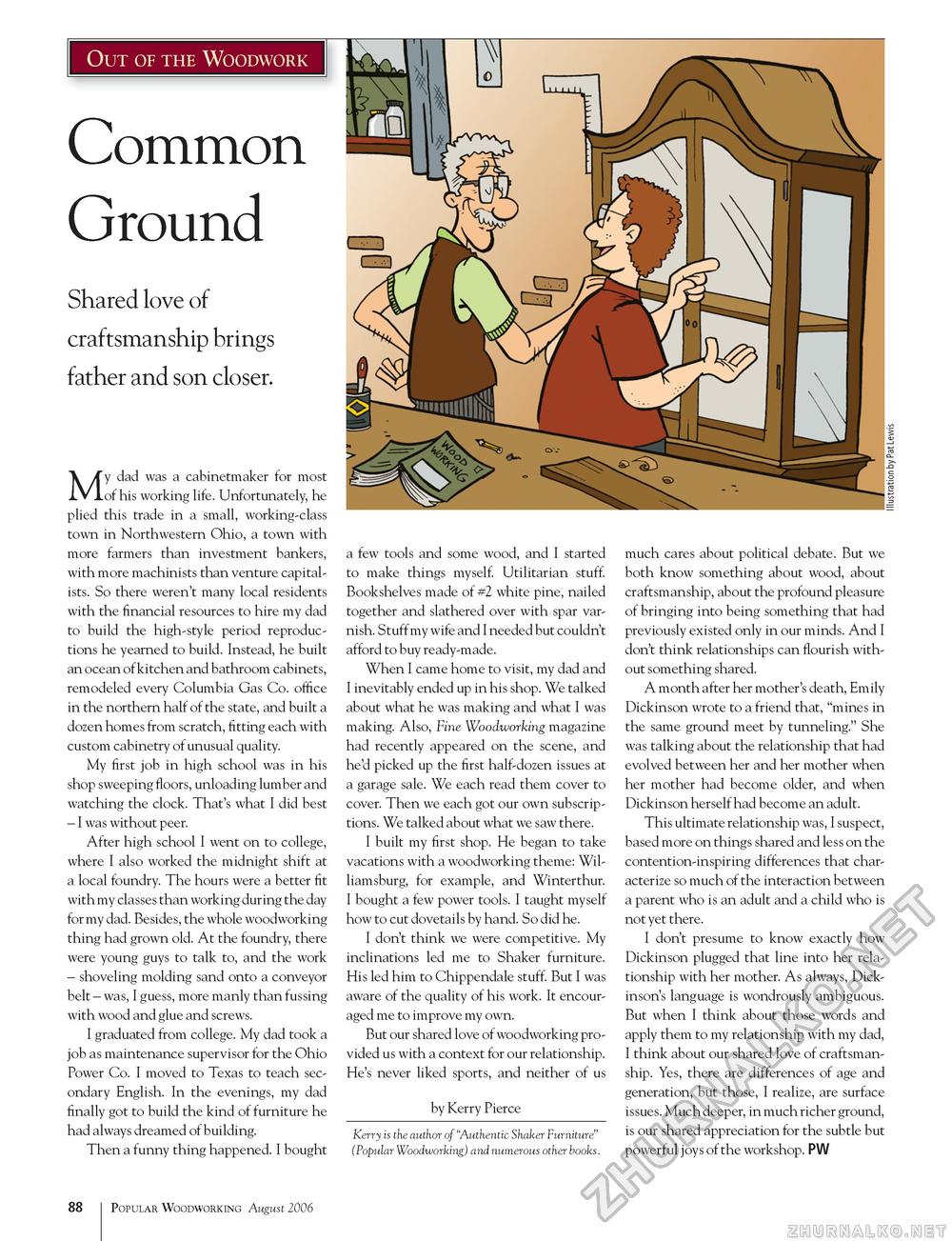Popular Woodworking 2006-08 № 156, страница 90
Out of the Woodwork Common Ground Shared love of craftsmanship brings father and son closer. My dad was a cabinetmaker for most of his working life. Unfortunately, he plied this trade in a small, working-class town in Northwestern Ohio, a town with more farmers than investment bankers, with more machinists than venture capitalists. So there weren't many local residents with the financial resources to hire my dad to build the high-style period reproductions he yearned to build. Instead, he built an ocean of kitchen and bathroom cabinets, remodeled every Columbia Gas Co. office in the northern half of the state, and built a dozen homes from scratch, fitting each with custom cabinetry of unusual quality. My first job in high school was in his shop sweeping floors, unloading lumber and watching the clock. That's what I did best - I was without peer. After high school I went on to college, where I also worked the midnight shift at a local foundry. The hours were a better fit with my classes than working during the day for my dad. Besides, the whole woodworking thing had grown old. At the foundry, there were young guys to talk to, and the work - shoveling molding sand onto a conveyor belt - was, I guess, more manly than fussing with wood and glue and screws. I graduated from college. My dad took a job as maintenance supervisor for the Ohio Power Co. I moved to Texas to teach secondary English. In the evenings, my dad finally got to build the kind of furniture he had always dreamed of building. Then a funny thing happened. I bought a few tools and some wood, and I started to make things myself. Utilitarian stuff. Bookshelves made of #2 white pine, nailed together and slathered over with spar varnish. Stuff my wife and I needed but couldn't afford to buy ready-made. When I came home to visit, my dad and I inevitably ended up in his shop. We talked about what he was making and what I was making. Also, Fine Woodworking magazine had recently appeared on the scene, and he'd picked up the first half-dozen issues at a garage sale. We each read them cover to cover. Then we each got our own subscriptions. We talked about what we saw there. I built my first shop. He began to take vacations with a woodworking theme: Wil-liamsburg, for example, and Winterthur. I bought a few power tools. I taught myself how to cut dovetails by hand. So did he. I don't think we were competitive. My inclinations led me to Shaker furniture. His led him to Chippendale stuff. But I was aware of the quality of his work. It encouraged me to improve my own. But our shared love of woodworking provided us with a context for our relationship. He's never liked sports, and neither of us by Kerry Pierce Kerry is the author of "Authentic Shaker Furniture" (Popular Woodworking) and numerous other books. much cares about political debate. But we both know something about wood, about craftsmanship, about the profound pleasure of bringing into being something that had previously existed only in our minds. And I don't think relationships can flourish without something shared. A month after her mother's death, Emily Dickinson wrote to a friend that, "mines in the same ground meet by tunneling." She was talking about the relationship that had evolved between her and her mother when her mother had become older, and when Dickinson herself had become an adult. This ultimate relationship was, I suspect, based more on things shared and less on the contention-inspiring differences that characterize so much of the interaction between a parent who is an adult and a child who is not yet there. I don't presume to know exactly how Dickinson plugged that line into her relationship with her mother. As always, Dickinson's language is wondrously ambiguous. But when I think about those words and apply them to my relationship with my dad, I think about our shared love of craftsmanship. Yes, there are differences of age and generation, but those, I realize, are surface issues. Much deeper, in much richer ground, is our shared appreciation for the subtle but powerful joys of the workshop. PW 88 Popular Woodworking August 2006 |







